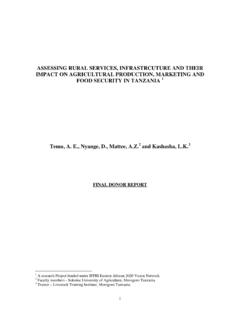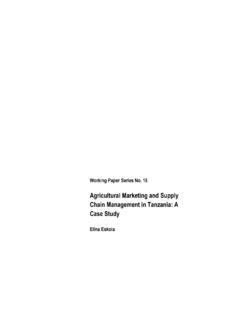Transcription of Equipment for Poultry Production - Encyclopedia of Life ...
1 UNESCO EOLSSSAMPLE CHAPTERSAGRICULTURAL MECHANIZATION AND AUTOMATION Vol. II - Equipment for Poultry Production - Gates, Encyclopedia of Life Support Systems (EOLSS) Equipment FOR Poultry Production Gates, Biosystems and agricultural Engineering, University of Kentucky, USA Keywords: agricultural engineering, animal health, animal housing, animal waste, animal welfare, Biosystems, broiler, broiler litter, chicken, egg, environment control, evaporative cooling, feed, heat stress, husbandry, indoor air quality, layer, life support systems, lighting, mechanical ventilation, modern meat Production , natural ventilation, nutrition, Poultry science, roaster, structures and environment, thermal environment, tunnel ventilation, vertical integration, veterinary science, waste management, water quality Contents 1.
2 Introduction 2. Types of Poultry 3. Types of chicken housing systems 4. Economic Impact of Poultry Production Factors Affecting Production Economic Structure of Industry 5. Housing Systems 6. Feeding Equipment 7. Watering Equipment Water Sources Water Delivery to Birds 8. Medication Equipment 9. Ventilation and Heating Fundamentals of Ventilation Ventilation Systems for Broilers Ventilation Systems for Layers Heating Equipment Air Distribution Control Systems for Heating and Ventilation 10. Lighting Need for Lighting in Layer Houses Need for lighting in broiler houses Lighting Sources 11. Harvesting Broilers Eggs 12. Waste from Poultry Systems Solid Waste Management Waste Handling Equipment Glossary Bibliography Biographical Sketch UNESCO EOLSSSAMPLE CHAPTERSAGRICULTURAL MECHANIZATION AND AUTOMATION Vol.
3 II - Equipment for Poultry Production - Gates, Encyclopedia of Life Support Systems (EOLSS) Summary This article provides a brief introduction to the science of Poultry Production . An astounding growth in Poultry Production has occurred during the last half of the 20th century, with large-scale integrated systems that incorporate all aspects of Production emerging to take advantage of economies of scale. Consequently, Poultry meat and eggs are now relatively inexpensive sources of protein in developed countries, and often the first meat-based protein source in developing agricultural economies. These benefits are achieved from improvements in engineering, genetics and nutrition. This article reviews the basics of the modern industry and how Equipment is used to automate activities and reduce physical hardships for growers.
4 Also, numerous pictures of modern facilities and Equipment are provided for the reader to envision the tremendous size of modern Poultry facilities, and to show specific pieces of Equipment . 1. Introduction Poultry are raised both for meat, and for eggs. Poultry Production spans the globe, ranging from simple backyard coops to highly advanced, technologically sophisticated rearing operations. Poultry Production in developing countries can provide a reliable protein source for growing populations, and its development can signal a countrys transition to a modern agricultural base. Modern Poultry Production relies on a sophisticated network of enterprises including feed milling, storage and delivery, bird Production facilities, hatcheries, breeding programs and their facilities, slaughtering plants, egg handling and storage facilities, and downstream marketing of final product.
5 The reader may be surprised to learn of the magnitude of typical Poultry facilities. For example, it is not uncommon for a single grower to be responsible for 50 000 to 100 000 or more chickens raised for meat, and as many as a million laying hens. Such intensive Production requires large material flows of feed, water, ventilation air, electricity, heat energy, lighting. In a sense, modern Poultry facilities are biological reactor vessels, with these factors as inputs, and the output being either meat or eggs. This article provides details regarding modern commercial Poultry Production Equipment . While some of this Equipment will be seen to be similar to that used in other livestock operations, the integrated nature of modern Poultry facilities has given rise to some specialized Equipment .
6 The nature of this Equipment is uniquely intertwined with the industrys highly developed and vertically integrated format. 2. Types of Poultry While Poultry are primarily reared for meat or eggs, other uses include leather and feathers, and in some regions, birds may be used in sporting events. The main types of Poultry include chickens, turkeys, ducks and ratites (emus, ostrich, etc). For meat Production , differences between Poultry types are mostly related to the length of the growth phase. Ratites are raised for meat and for other products including feathers and leather, but will not be discussed here. UNESCO EOLSSSAMPLE CHAPTERSAGRICULTURAL MECHANIZATION AND AUTOMATION Vol. II - Equipment for Poultry Production - Gates, Encyclopedia of Life Support Systems (EOLSS) For the purposes of this article, the terms broilers and layers shall be used to denote meat-type and egg-producing birds, respectively.
7 The majority of Poultry used worldwide are chickens, although turkeys and to a lesser extent ducks account for significant meat Production . Thus, Equipment for a broiler chicken will generally be similar to that for a turkey reared for meat, unless specifically noted. 3. Types of Chicken Housing Systems Broilers and Turkeys Modern meat-type chickens, commonly called broilers, are typically raised in large buildings ( houses ). Birds are placed in these houses when newly hatched and may remain in the same house until removed for slaughter. Feed, water, light, and environment control are constantly provided. A typical broiler house may house 16 000 to 28 000 birds. Turkeys are grown in similar houses, but they may be moved between two or three houses during their growth because they are grown to much larger weights than are broiler chickens.
8 Layers Modern egg-producing Poultry , or layers, are typically raised in large buildings in cages arranged in tiers. These tiered cages are configured to provide feed and water, and allow for the ready removal and transport of eggs. Cage sizes, and number of birds per cages, vary by country according to customs and regulations. A typical layer house may contain 100 000-200 000 birds. It is common for multiple houses to be connected together at one end for automating egg collection, and feed and water delivery tasks. Layer houses may be either single storey or "high-rise" structures with room below the growing area for manure storage. Breeding Flocks Modern Poultry Production includes flocks of parent birds ( breeders ) to produce fertile eggs for broiler or layer operations.
9 Housing is typically similar to broiler and turkey housing, but feeding, light control and density of birds are much different. 4. Economic Impact of Poultry Production Table 1 lists gross output of the worlds larger Poultry producers, for both meat and eggs. These data are published annually in a number of sources, including the United States Department of Agricultures agricultural Statistics Service, and others. The largest producers of Poultry meat include United States, China, European Union and Brazil. The largest producers of eggs include China, , Japan and India. These differences in Production arise from a number of different factors, including feed cost and availability, market restrictions and regulations on Production and environment effects, and the development of export markets.
10 Broilers (tonnes) Eggs (tonnes) North America 17,615 109,656 UNESCO EOLSSSAMPLE CHAPTERSAGRICULTURAL MECHANIZATION AND AUTOMATION Vol. II - Equipment for Poultry Production - Gates, Encyclopedia of Life Support Systems (EOLSS) 15,021 77,256 South America 6370 24,380 Brazil 4441 16,890 European Union 8319 82,724 France 2307 16,350 Italy 1170 12,050 United Kingdom 1477 10,700 Germany* 717 13,900 Asia 16,618 425,483 China 12,500 328,000 Japan 1235 43,200 India 595 29.

















